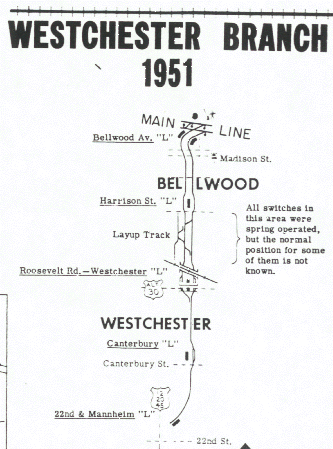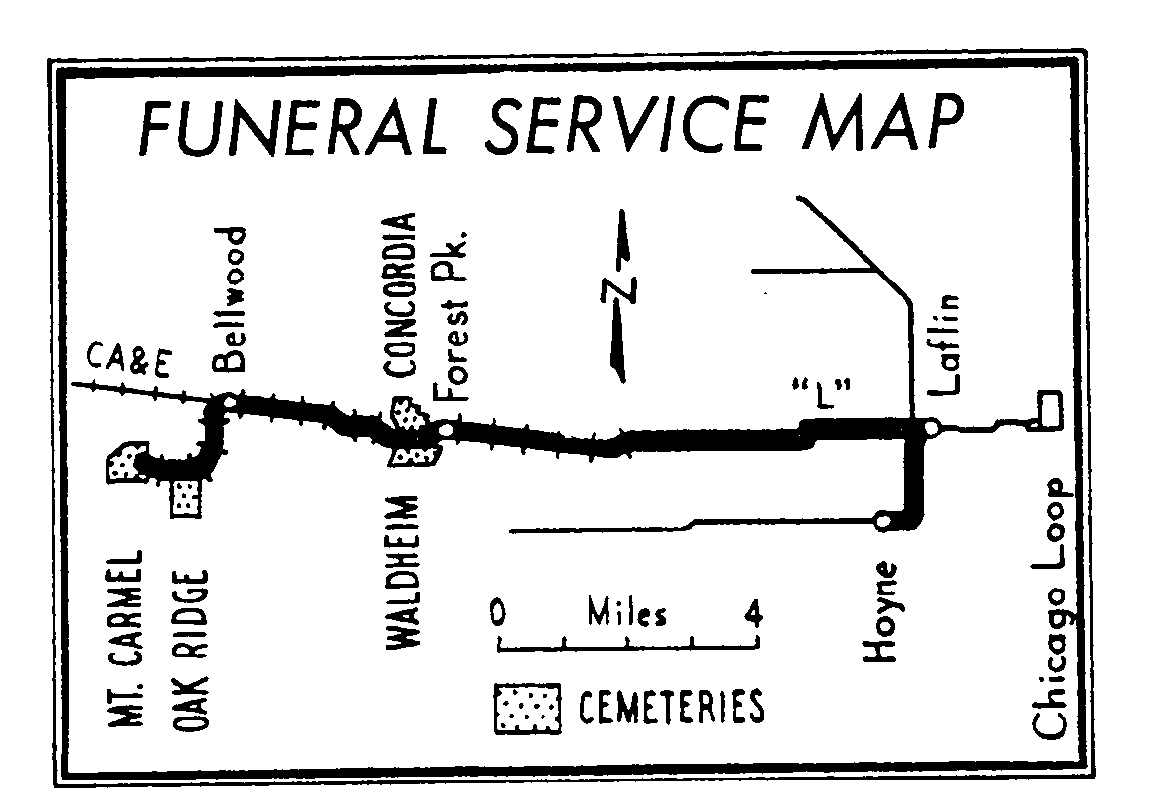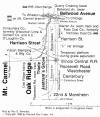www.FranzosenbuschHeritageProject.org
Home
On this page:
Please note the small "thumbnail"
pictures can be expanded by double-clicking on them.
Local History: Westchester's Rapid Transit Line (1920's-1950's)
Back in the early days of the Village of Westchester
Samuel Insull, William Zelosky and many
others were instrumental in establishing an interurban
shuttle line to service the growing community. The rural Westchester
branch of the Metropolitan "L", a line constructed primarily to help sell real
estate that belonged to associates of CA&E president Thomas Conway. The
line was built as a single-track two-mile extension. The tracks ran from
the Chicago, Aurora and Elgin line Bellwood station to near the current
intersection of Mannheim and Cermak with intermediate stops at Harrison,
Roosevelt Road and Canterbury. The text of the
Westchester Rapid Transit Contract is available for your review.
From this document we can determine this branch was but the first leg of what
was to be a much longer line extending to Warrenville, Illinois.

 At one end of the line was
the Bellwood station at Bellwood Avenue near Madison Street, Bellwood.
Work on the Bellwood Avenue station nears completion in February 1926.
At one end of the line was
the Bellwood station at Bellwood Avenue near Madison Street, Bellwood.
Work on the Bellwood Avenue station nears completion in February 1926.
Photo from the Louis F.
Gerard Collection

 The
Harrison Street stationhouse, unlike stationhouse at Roosevelt, stands beside
the track bed. On a sign in the background we can barely make out a
William Zelosky Company advertisement in this enlargement.
The
Harrison Street stationhouse, unlike stationhouse at Roosevelt, stands beside
the track bed. On a sign in the background we can barely make out a
William Zelosky Company advertisement in this enlargement.
Above photos from the Charles N. Field
 Work
is well underway for the underpass that will carry the Westchester branch under
Roosevelt Road. (The Photo is from the South Shore Interurban Historical Society Collection.)
Work
is well underway for the underpass that will carry the Westchester branch under
Roosevelt Road. (The Photo is from the South Shore Interurban Historical Society Collection.)

 Once
the construction was completed double tracks rain to just south of Roosevelt
Road. Here are two 1929 photographs of the rails between the Harrison and
Roosevelt stations. Photos from
the Chicago, Aurora and Elgin collection, possibly photographed by Charles N.
Field.
Once
the construction was completed double tracks rain to just south of Roosevelt
Road. Here are two 1929 photographs of the rails between the Harrison and
Roosevelt stations. Photos from
the Chicago, Aurora and Elgin collection, possibly photographed by Charles N.
Field.

A close-up view of the Roosevelt Road
station on the Westchester Line. The distinctive bus stop sign near the front
door belongs to the Sam Insull-controlled Metropolitan Motor Coach Company.
 It is difficult to see but a small sign in this
photograph is the distinctive bus stop logo for
Samuel Insull's bus coach lines.
It is difficult to see but a small sign in this
photograph is the distinctive bus stop logo for
Samuel Insull's bus coach lines.
Photos from the Louis F.
Gerard Collection
 The
Roosevelt Road station's size can better be judged by the view from the opposite
side. This Charles N. Field photograph is from the walkway above the
tracks. Walkways such as this and others on the Westchester line permitted
people to cross the rail line without being blocked by the tracks or 'trolley'.
Photos from the Charles N. Field
The
Roosevelt Road station's size can better be judged by the view from the opposite
side. This Charles N. Field photograph is from the walkway above the
tracks. Walkways such as this and others on the Westchester line permitted
people to cross the rail line without being blocked by the tracks or 'trolley'.
Photos from the Charles N. Field

 The Canterbury station consisted of a small Tutor
Revival-influenced wooden
station house, with half-timbered wall surfaces and a steep, front-facing peaked
gable extending over the entrance, exiting onto a small platform. It was served
by a one-car shuttle that made connections with Loop-bound
trains at Roosevelt. This was more than ample service for the undeveloped area.
In 1933 the shuttle was replaced with a through car that was uncoupled from a
train at Roosevelt.
This is a picture of the interior of the Canterbury station in 1930.
The Canterbury station consisted of a small Tutor
Revival-influenced wooden
station house, with half-timbered wall surfaces and a steep, front-facing peaked
gable extending over the entrance, exiting onto a small platform. It was served
by a one-car shuttle that made connections with Loop-bound
trains at Roosevelt. This was more than ample service for the undeveloped area.
In 1933 the shuttle was replaced with a through car that was uncoupled from a
train at Roosevelt.
This is a picture of the interior of the Canterbury station in 1930.
Photo
on the above left from the Krambles-Peterson Collection. Photo on the
above right by Charles N. Field.
 Today
Westchester Masonic Temple sits on the site of the Canterbury station.
Today
Westchester Masonic Temple sits on the site of the Canterbury station.
Photograph by Jim Arbuthnot

Carpenters are putting the finishing
touches on the Mannheim/22nd terminal in December 1930.
Photo from the Chicago Transit
Authority Collection

Car 4352 is on the solitary duty of providing shuttle service between the
Roosevelt and Mannheim/22nd
stations on the Westchester branch on November 20, 1941. It was not uncommon
that the motorman and conductor were the sole occupants of the car.
Photo from the Collection of Gordon E.
Lloyd

The depression devastated the holdings of many including
Samuel Insull. Reduced ridership on
the entire Chicago transit system and particularly the Westchester shuttle line
caused the line to wither. By
1951, the station house and working lights were gone. Its low ridership is all
too evident.
Photo by B. L. Stone
Services were discontinued December 8, 1951 when the CTA
discontinued service west of Des Plaines. No sooner had the tracks been removed
than Westchester experienced an enormous postwar development boom, missing the
line's service by mere months.

The current occupant of location of the Mannheim/22nd
station is the Mid-America Bank in Westchester.
Photograph by Jim Arbuthnot
More pictures of the Westchester line are available on the
Development Efforts in the 1920s
page. Also see these newspaper articles:
Local History: Mount Carmel and Oak Ridge Line (1906-1920's)
 Before the Westchester branch
served the area another special branch existed in the
area branching off the Chicago Aurora and Elgin Railroad. It was
constructed in the winter of 1905-1906 at the urging Catholic church officials
and ran through Westchester and Hillside paralleling Roosevelt Road and Twelfth
Avenue to just west of Wolf Road. Stops were at both
the Mount Carmel and Oak Ridge Cemeteries. This service was a significant
improvement to an uncomfortable horse-drawn wagon traveling often treacherous
unpaved roads during periods of rain or snow. Other lines already serviced
the Waldheim and Concordia Cemeteries.
Before the Westchester branch
served the area another special branch existed in the
area branching off the Chicago Aurora and Elgin Railroad. It was
constructed in the winter of 1905-1906 at the urging Catholic church officials
and ran through Westchester and Hillside paralleling Roosevelt Road and Twelfth
Avenue to just west of Wolf Road. Stops were at both
the Mount Carmel and Oak Ridge Cemeteries. This service was a significant
improvement to an uncomfortable horse-drawn wagon traveling often treacherous
unpaved roads during periods of rain or snow. Other lines already serviced
the Waldheim and Concordia Cemeteries.
The line went into service on March 18, 1906. In
addition to charter service a passenger service was provided by a single shuttle
car that met mainline trains in Bellwood. By October 1907 the line was
averaging twenty-two funeral charters a week. For exceptional large
funeral parties, additional cars were pulled from the regular passenger fleet.
In one occasion a ten-car train was required.

First one, then four more cars
were modified with the removal of all advertising signs and the addition of dark
green carpets and drapes. One such car was Number 800 seen here at its Oak Ridge stop.
 In 1907 Car 756
was rebuilt to service the needs of the funeral parties. Once rebuilt and
renumbered to 2756 the car more closely resembled the closed-end cars of the
790-927 series.
In 1907 Car 756
was rebuilt to service the needs of the funeral parties. Once rebuilt and
renumbered to 2756 the car more closely resembled the closed-end cars of the
790-927 series.
Photo from the
Fred Borchert / Robert Gibson Collection
- Baggage-style doors had been added complete with leaded
stained glass windows.
- The passenger compartment was finished in polished
weathered oak inlaid with narrow strips of black and yellow with twenty-eight
individual rattan chairs. The floor was covered in finely figured green
carpet. A lavatory and storage closet was provided.
- The casket compartment floor was covered with green
linoleum. The ceiling was painted a light yellow. The casket
compartment was eleven feet long -- large enough to handle two caskets if
needed.
- All the hardware for the doors and windows was done with a
statuary brass finish.
 The
Mount Carmel Cemetery station was tastefully designed on a large scale. It
is seen here with the rail car parked at its end. The station had special
facilities for both the handling of the caskets and the needs of the bereaved.
The
Mount Carmel Cemetery station was tastefully designed on a large scale. It
is seen here with the rail car parked at its end. The station had special
facilities for both the handling of the caskets and the needs of the bereaved.
Photo from the Electric
Railway Review
On November 1, 1926 the shuttle car was replaced by the #17 bus
running from the newly opened Roosevelt Road station on the
Westchester branch. Direct
rail service continued to be provided on major holidays such as Decoration
(Memorial) Day and Independence Day for those people wishing to pay their
respects.
Numerous sources were used for this page.
We intend on adding more information as time and resources allow.
Please feel free
to contact me at j.arbuthnot@sbcglobal.net.
I will route your email through our other researchers.
Last Modified: 07/13/2006













 Before the
Before the 